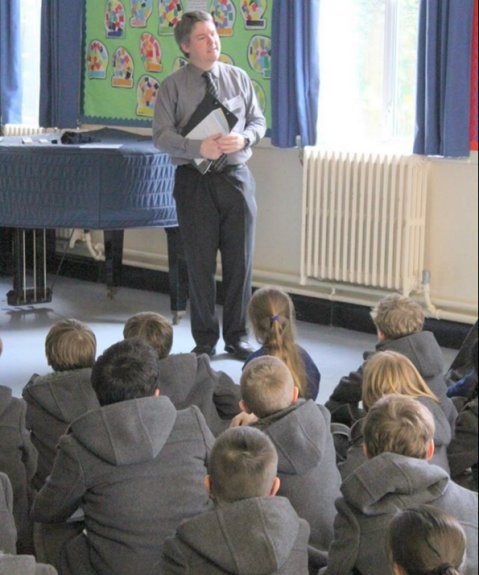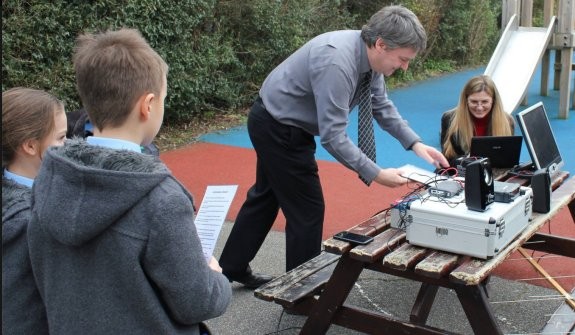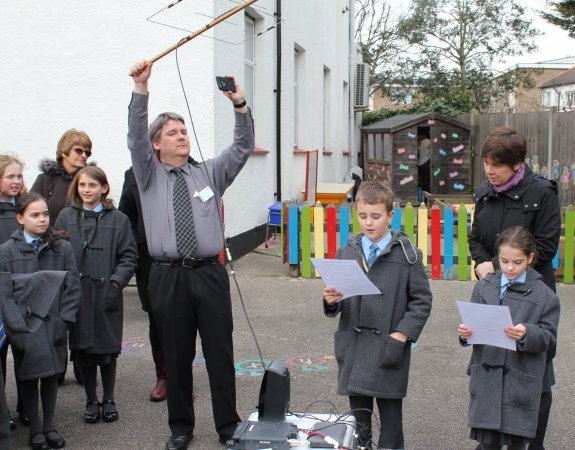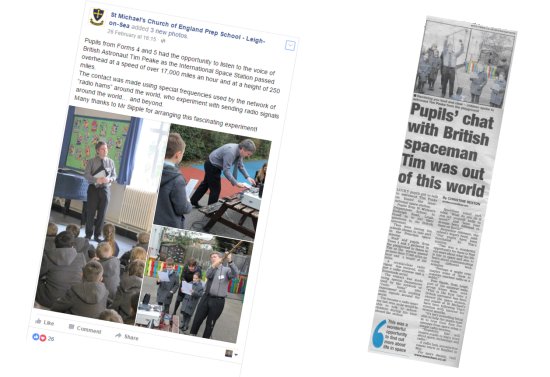On Friday the 26th of February 2016, pupils of the City of Norwich School successfully made contact with Tim Peake aboard the ISS, and pupils of a school in South Essex were given the chance to listen to the live contact, as part of their International Space Station projects.
St Michael’s Preparatory School in Leigh-on-Sea has been studying the Principia mission, and is one of the schools taking part in the Rocket Science project, where they are set to receive seeds that have spent time aboard the ISS and grow them on Earth. The pupils have also been following the various video feeds of Tim’s science experiments. Working with Essex Ham, the school was offered the chance to hear live signals from Tim Peake, during his schools contact with the Norwich school on the 26th of February.
With more contacts scheduled between now and Tim’s return to Earth, other clubs and schools might like to try something similar to encourage youngsters to take an interest in space and radio. Here’s a summary of how the afternoon went:
Before the contact
In the days running up to the contact, we’d worked closely with the school to find a pass that would fit in with the school’s timetable and that the right classes would be available and briefed.
In the pass immediately before the ARISS schools contact, the ISS digipeater was active, so two messages were sent, containing greetings to the ISS and other amateurs from Year 4 and Year 5 at St Michael’s School. It was successfully digipeated and received in Norway, Germany and The Netherlands – Extract from ariss.net:

Fifteen minutes before the contact, 80 pupils from Year 4 and Year 5, plus staff from the school, gathered in the main school hall. The main screen was showing the excellent ARISS Principia dashboard, plus a live feed from the City of Norwich school. Pete M0PSX explained to the keen pupils how we’d be listening in to a live message from space, and explained that we’d been able to make contact via packet – To keep it simple, this was explained as “using radio to send a text message to the ISS” – not entirely accurate, but appropriate for the 8 to 10 year old audience.

Receiving the Contact
The two years then exited the hall to stand in the playground, where a modest station (Yaesu FT-7900 run from a 12V SLAB) was set up and tuned to 145.800. It was explained that we’d only be able to hear the downlink, so two volunteers offered to read the questions from a laminated sheet we’d prepared earlier, so that the other pupils would know what questions Tim was answering.
The school building obscured line-of-sight for the first part of the pass, which was fairly low on the horizon, so we only started to hear Tim on around question 4. The antenna was a home-made 2m Yagi, created by Steve M0SHQ (on loan to Pete – thanks Steve!), lined up using an iPhone satellite tracker. Battery-powered speakers were used to boost audio for the audience.

After the signal was lost, Sarah M6PSK switched audio from the Yaesu FT-7900 to the ARISS stream, just in time to allow the students to hear the last question, the “goodbye” from the Norwich school, and the final ‘over’ from Tim. A battery-powered monitor was also running to show the live video, including the Ham TV video.

Post-Contact
Always a good sign. After the contact. Pete asked for questions, which were non-stop for about 10 minutes. Some were about the ISS and some about radio, but it showed a high engagement level from the pupils, and the teaching staff report a “buzz” as a result of the experience.
We have followed up by suggesting that pupils watch the “Amateur Radio A 21st Century Hobby” video as part of future lessons on the ISS, and have been asked to return to allow other years the chance to hear live signals.
Essex Ham and St. Michael’s jointly worked on a press release, which can be found on our Essex Amateur Radio Press Releases page. A report on the events appeared in the local paper. Despite the joint press release being clear, the final article gave the impression that St Michaels spoke to Tim, as opposed to hearing Tim, but still great PR for the hobby locally.
St Michael’s School also promoted the event via the school newsletter and on their social media channels.

There’s also a short video clip on the St Michael’s Facebook page – This only captures the Internet portion of the contact, after we’d lost radio signal, but gives a feel for the set-up.
Other notes
If you, or your club, is looking to help out with a local school’s activities, it’s well worth looking at becoming a STEM Ambassador. STEM stands for Science, Technology, Engineering and Maths, and Ambassadors receiving training on how to work with schools on this type of project. Crucially, STEM Ambassadors are made aware of issues around safeguarding in schools, and are DBS checked. This means that paperwork can be supplied to schools, and schools get the reassurance of knowing that Ambassadors are aware of key safeguarding issues. Locally, ExploreSTEM deals with recruiting STEM Ambassadors and liaising with schools.
RSGB club affiliation is also a bonus, as the schools can also be reassured that public liability cover is in place, and leaflets / material can be provided during events like this.
Related Links
- ARISS Principia Schools Contacts
- St Michael’s School
- Other ARISS / ISS Features
- ARISS Interview with Kenneth N5VHO
- Tim Peake ISS Amateur Radio Contacts
- ARISS – Amateur Radio on the International Space Station
- Our Guide to Working the ISS
- AMSAT UK
Our thanks to the staff and pupils of St Michael’s School for allowing us to help with this experiment, and for the images used for press coverage of the event.

